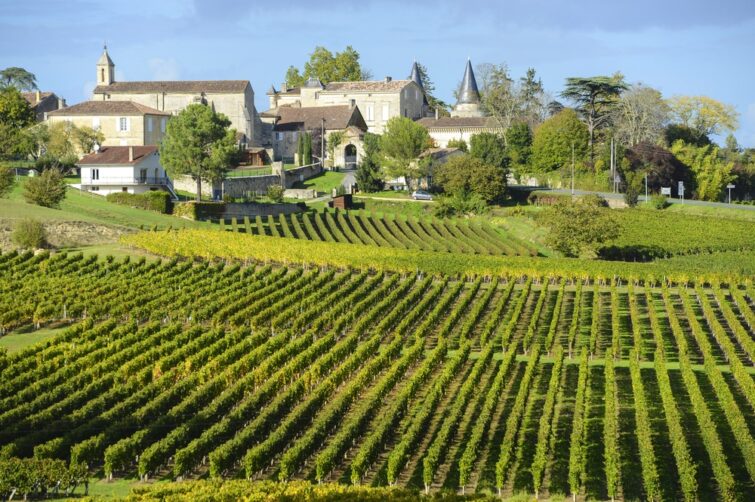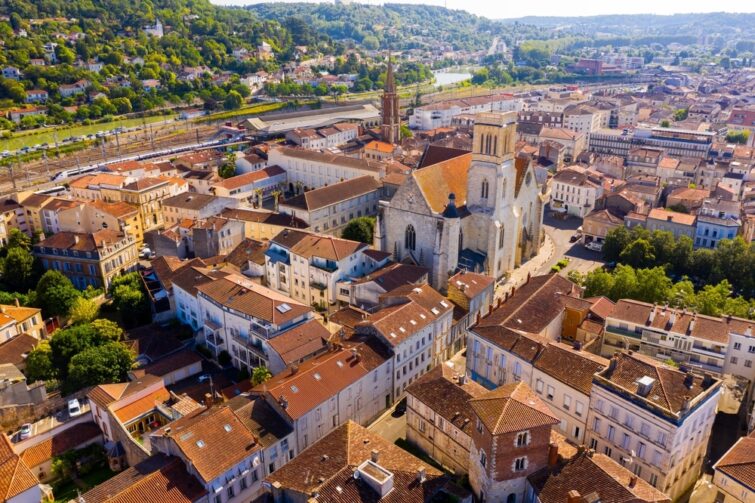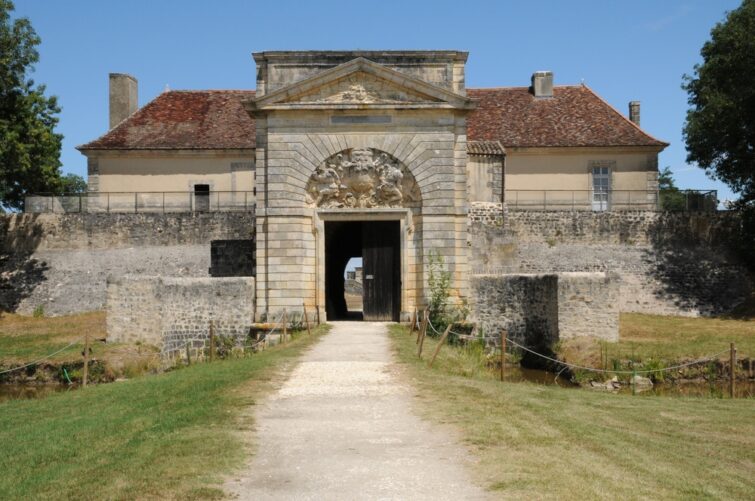Are you planning a cultural holiday in the West of France? Discover the UNESCO World Heritage sites in Aquitaine.
Summary
- 1. Bordeaux, port of the Moon
- 2. The Jurisdiction of Saint-Émilion
- 3. The routes to Santiago de Compostela in France
- 4. The abbey church of Saint-Savin-sur-Gartempe
- 5. The prehistoric sites and decorated caves of the Vézère valley
- 6. Cité Frugès – Architectural work of Le Corbusier in Pessac
- 7. Verrou Vauban from the Gironde estuary to Blaye
- 8. Cordouan Lighthouse
France stands out among the good students of Unesco Heritage with 44 sites in this list, including 8 in New Aquitaine. All so different from each other, they illustrate the diversity of this territory with a thousand and one faces. Between the vineyards of Saint-Émilion , the architecture of Le Corbusier and the presence of Bordeaux , discover this unique cultural heritage.
On an adventure with the 8 UNESCO World Heritage sites in Aquitaine!
1. Bordeaux, port of the Moon

Photo credit: Shutterstock – Cedric33
We had to start this article of Unesco sites in Aquitaine with the luminous city of Bordeaux in the South-West of France. World capital of wine, it nevertheless obtained its letters of nobility in 2007 thanks to its historical monuments inherited from the Enlightenment. That is to say for how many centuries, the city shines on the banks of the Garonne. Moreover, it is even the first urban complex in the world distinguished over such a wide area. Indeed, the Unesco perimeter includes half of the city!
Bordeaux undeniably has a remarkable homogeneity with regard to its buildings. The architecture made of light, classy and neoclassical stone attracts all the attention of visitors and locals. Bordeaux residents are proud to have the most protected buildings after Paris (347 precisely!). All the more reason to get lost in the alleys and stroll with your nose in the air in front of the ornate balconies. The architectural details will lead you to the water mirror on the Place de la Bourse and to the Quinconces.
2. The Jurisdiction of Saint-Émilion

Photo credit: Shutterstock – FreeProd33
Not far from Bordeaux, wine culture is in full swing in the Jurisdiction of Saint-Émilion. The latter is made up of a set of 8 municipalities according to a statute established in the 13th century by the King of England Jean-Sans-Terre.
In 1999, the jurisdiction even became the first wine-growing territory to be classified as a World Heritage Site under the title of “exceptional cultural landscape. Unesco highlights its “remarkable historic wine-growing landscape” as well as “its intensive cultivation of wine vines in a delimited region”. These towns also have a set of religious monuments, abbey or cathedral dating from the 11th and 12th centuries. Among them the Monolithic Church carved into a rocky promontory.
Because of its reputation, Saint-Émilion attracts many holidaymakers during the high season. If you want to walk the streets of this Unesco site in Aquitaine away from the crowds, visit the vineyards in low season.
3. The routes to Santiago de Compostela in France

Photo credit: Shutterstock – BearFotos
While all roads lead to Rome , several trails in Europe lead to the Ways of Santiago de Compostela . In New Aquitaine, many pilgrims reach the sanctuary from Spain via the Pyrenees .
They cross villages marked by an incredible French heritage and often well preserved throughout their journey. Cathedrals, churches, hospices, basilicas and abbeys listed as world heritage sites in 1998 follow one another in turn on their route. We couldn’t name them all, because there are no less than 71 scattered on the way to Santiago de Compostela.
In New Aquitaine, hikers will come across 23 buildings . Among the best known are the cathedrals of Bordeaux, Agen, Bayonne and Périgueux.
4. The abbey church of Saint-Savin-sur-Gartempe

Photo credit : Wikimedia – GO69
The abbey church of Saint-Savin-sur-Gartempe, one of the most beautiful Unesco sites in Aquitaine, was registered there in 1983. It became so under the title of “masterpiece of the creative genius of man” and ” remarkable testimony to a lost civilisation”. This “Romanesque Sixtine” according to André Malraux is located to the east of Poitiers in Vienne.
In this major heritage site, you will discover 700 m2 of wall frescoes from the 11th and 12th centuries. They are still very well maintained considering their age. The incredible religious building therefore has the largest set of mural paintings in Europe inherited from this period. Its 61 scenes retrace the most important episodes of the Old Testament on the vault of the nave. During your stay in Poitiers, also visit its Romanesque church Notre-Dame-de-la-Grande and its Saint-Pierre cathedral.
5. The prehistoric sites and decorated caves of the Vézère valley

Photo credit: Shutterstock – spatuletail
In 1940, two boys stumbled upon a discovery that would change our ancestors’ vision of the Paleolithic. The Lascaux caves are emerging from their clandestine life after years of sleeping underground. Then you know the story, unique animal frescoes, a wealth of colors and a simply majestic ensemble.
But this region of Périgord Noir has other equally impressive caves. Explore the Combarelles cave and its 800 quaternary fauna engravings. In 1979, 15 sites of the Périgord Noir in the Dordogne were classified as world heritage sites by Unesco. The Vézère valley has no less than 147 sites from the Palaeolithic era and 25 decorated caves ! You will discover the parietal art there as you will never see it elsewhere.
6. Cité Frugès – Architectural work of Le Corbusier in Pessac

Photo credit: Flickr – Fred Romero
Here, you change register with the architectural works of Le Corbusier listed on the UNESCO World Heritage List in 2016. The Frugès city comes to life under the innovative eye of the architect Corbusier in 1926 in Pessac.
At that time, he wanted to break the codes and turn to a more modern movement than his peers. He then designed habitats with refined geometric shapes, quite avant-garde for those years. You will discover seven different genres: skyscrapers, quincunxes and zigzags, twins, arcades and two types of isolated houses.
The city and the Frugès-Le Corbusier house reveal all their secrets to you during guided tours by reservation only.
7. Verrou Vauban from the Gironde estuary to Blaye

Photo credit: Shutterstock – Pack-Shot
Built in 1689 and listed on the UNESCO heritage list in 2008, Fort Médoc is the work of the famous engineer Sébastien Vauban. Built under the aegis of Louis XIV, it protected the city of Bordeaux from possible enemy attacks from the Gironde estuary.
It is still made up of three fortifications today: the citadel of Blaye, Fort Médoc and Fort Pâté in Cussac-Fort-Médoc. You can visit the first for free and the second with a paid entrance ticket. The last one cannot be visited.
8. Cordouan Lighthouse

Photo credit: Shutterstock – Stephane Bidouze
You are surely wondering what is the last Unesco site in Aquitaine? The Cordouan lighthouse in 2021! The “ Versailles of the Seas” has stood proudly for more than 400 years in the Gironde estuary. Indeed, this masterpiece of architecture has served as a guide for sailors since 1611. Moreover, for the little anecdote, it is the only lighthouse built to replace the mythical lighthouse of Alexandria .
Visit the lighthouse in the presence of a keeper from April to October . You get there by cruise ship from Verdon or Royan depending on the tide and the coefficients. The interior of the king of lighthouses takes you on a discovery of the royal chapel, the king’s apartments and the Salle des Girondins. The highlight of this cultural visit: the panoramic view between land and sea after the 301 steps. We counted almost all of them during our ascent!
